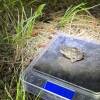Wildlife encounters are pretty common in the Greater Boston area, from wild turkeys at crosswalks to coyotes in yards. Well-publicized coyote attacks in recent years and an uptick in sightings this year have some people worried. Wildlife biologist Susan McCarthy from the Massachusetts Division of Fisheries and Wildlife joined GBH All Things Considered host Arun Rath to help us understand coyote activity in the area. This transcript has been lightly edited for clarity.
Arun Rath: So first, could you start off by giving us maybe a bit of a coyote reality check? Are we seeing significantly more sightings in encounters than in the past? And does that mean there are more coyotes on the ground in Eastern Massachusetts?
Susan McCarthy: Well, what I can say is that it does seem as though there are more reports of coyotes in suburban and urban environments. But whether or not that means there are more coyotes on the landscape is a great question to ask. And so what we've determined is that over the past 10 years, the coyote population in Massachusetts has stabilized. Coyotes are existing at very high densities and they're in all available habitats throughout the commonwealth of Massachusetts. We wouldn't say that the coyote population is growing. ... We know that's not true. That's not the case.
But what we do know is that coyotes are utilizing suburban and even urban environments very heavily, very commonly. And in doing so, they have lots of day-to-day interactions with people. And people, of course, nowadays always have a phone at the ready to take pictures and videos and document their experiences, and share those experiences regularly.
Rath: So then I guess the next reality check is help us then balance those reports with the real risk assessment here, because there are some scary stories. You know, it was just down the road from me here in Arlington last year where we had a couple of toddlers that were attacked by a coyote. How much of a threat, though, are coyotes to humans and our pets in reality?
McCarthy: So I do like to preface all of these conversations with letting people know that coyotes, generally speaking, they're not posing any kind of a real threat to human health and safety the vast majority of the time. But you're correct, there are instances that have occurred where coyotes are, arguably, a public safety risk.
The reality is that coyotes, while they're not usually a threat to people, they are unquestionably a threat to our domestic pets, particularly when we leave our pets unsupervised outdoors. So when it comes to pet ownership, we're constantly reminding folks, if you have a cat, please keep that cat indoors [because] that's where it's going to be safest. As far as dogs go, please ensure that your dog is always leashed and under close supervision, under good voice command, and know that if you do take your dog off leash — especially taking them for hikes — you do run the risk of your dog interacting with wild animals, not just coyotes, but other wild animals as well.
As far as threats to human health and safety, again, those are very few and far between, but we have had instances. And over the past five years or so, there's been an uptick in these instances. And what we've seen is that the vast majority of time when these when coyotes are having these negative interactions with people, we see that there's a link to artificial or intentional feeding. So we see that there's certainly a connection between problematic behavior in coyotes and their access to human-associated food sources.
I understand that folks are very hesitant to use harassment techniques, but it is a really important message to send to folks not only that we want to be removing food attractants that bring these animals into our backyards, but when we do see these animals that we're actively and aggressively harassing them. And the reason for that is because it's essentially using your body language to communicate to that animal that you're the dominant individual, that this is your territory. So you're teaching that animal, using negative conditioning, that when you come into my territory — my home — something frightening is going to happen to you that could threaten your life.
Rath: Does the Massachusetts Division of Fisheries and Wildlife actively manage the coyote population? Or, you know, how how how do you approach that?
McCarthy: So that's a great question. And oftentimes we hear from folks that that are looking to us to actively manage the coyote population. And the reality is, is that it takes very high levels of lethal removal in order to actually manage — and when we're talking about managing [that means] reducing coyote populations. So we know from the scientific literature that it would take a removal of 70% or more of a coyote population year after year in order to see a decrease in the number of coyotes on the landscape, and we know that that's just not feasible.
So to answer your question, do we manage coyotes? Perhaps not in the sense that that you're implying that we're actively reducing coyote populations. That's not something that's really an option on the table. We know from examples from a number of other states that in our U.S. history that coyotes have been persecuted for a very long time. We know that these animals have been actively poisoned. There have been bounties on these animals. There have been open, very liberal, year-round hunting seasons. And none of those things have ever resulted in the reduction of coyote populations.
So what I can say is that coyotes are here in the United States. They're here in the Northeast, in Massachusetts. They're here to stay. The population isn't going to be decreasing. And there really isn't anything that can be done to decrease coyote populations.








